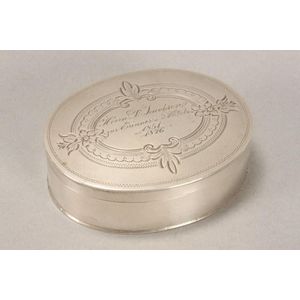Altona Silver Memorial Box with Foliate Decoration
German silver box and cover, Altona city mark to base, of oval form, the cover with foliate bright cut decoration and central reserve with inscription in memoriam for a deceased, with further engraving to inner cover and base, weight 59gm, length 7.5 cm
You must be a subscriber, and be logged in to view price and dealer details.
Subscribe Now to view actual auction price for this item
When you subscribe, you have the option of setting the currency in which to display prices to $Au, $US, $NZ or Stg.
This item has been sold, and the description, image and price are for reference purposes only.
- Foliate - Decorated with leaves or leaf-like forms.
- Bright Cut Decoration - Bright cut decoration is a technique used to decorate silver and other metal objects, such as jewellery and flatware, with intricate and detailed patterns. The technique involves using a small, sharp tool called a graver to carve designs into the surface of the metal. These designs are then polished, creating a bright, reflective surface that contrasts with the surrounding metal. The designs can be simple or complex, and can include geometric shapes, scrolling vines, and other decorative elements. The technique is highly skilled and requires a lot of precision, patience and attention to detail.
Bright cut decoration was widely used in the 18th and 19th centuries, particularly in the silverware and jewellery industries. It was popular in the United States, Great Britain and Europe.
Today, bright cut decoration is still used by some craftsmen and artists, but it is considered a traditional technique and is not as widely used as it was in the past. However, the bright cut decoration on a silver object is still considered a sign of quality and craftsmanship and is highly prized by collectors of antique silver and other metal objects.
This item has been included into following indexes:
